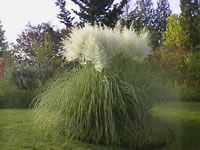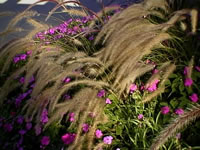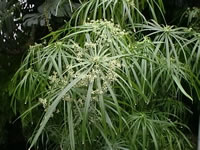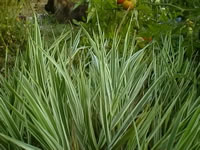How to Grow and Care for Ornamental Grasses
in your Garden or Landscape
Grasses have always been a part of the natural landscapes of the earth.
Because of its durability and versatility, ornamental grass is being used more and more frequently in home and business landscape designs.
|
|
|
Ornamental grasses can be used as fillers or specimens, border plants or background plantings, as ground covers or screens, or they may be grown as container plants.
Their adaptability and subtle beauty make them perfect companions to flowering plants and other woody ornamentals.
To fully appreciate the beauty, diversity and usefulness of ornamental grasses they should be viewed in a garden setting. It is impossible to appreciate all of the attributes of these plants when they are sitting with a dozen others, on a bench at the nursery.
Ornamental grasses are available in a wide array of colors, shapes, textures and sizes. The flowers and subsequent seed heads are equally diverse, ranging from "ho-hum" to truly spectacular.
Each grass species has it's own unique form. They may form low compact mounds, tall screens, or densely spreading mats. The foliage colors include various shades of green, blue and red, as well as variegated varieties having red, white or yellow foliage banded with ivory or yellow stripes. In the fall, the spring and summer colors change to hues of red, beige, or brown, providing a great winter garden accent.
|
The flower spikes (also known as inflorescences) can be found in different shades of maroon, red, pink, silver, white, yellow, or beige and are excellent for drying.
With ornamental grasses, looks aren't everything. They add a dimension of motion and of sound to your landscape. The gentle waving motion of the grasses, and the accompanying sounds create a very peaceful atmosphere within your garden. The grass's animated movements will change with the seasons (dry and living grasses appear and sound quite different).
Once established, ornamental grasses require very little care. These durable, low maintenance plants will not only add distinction to your
landscape during the summer months, but they will be quite dramatic in the winter landscape as well. |
|
|
The number of grasses that are cultivated for home gardens is always increasing through hybridizing and discovery. They are available in a wide range of height, spread, color, and flowering times. You are probably already familiar with Pampas Grass, but don't overlook the Purple Fountain Grass, Maiden Grass, Zebra Grass, Blue Fescue, or many other varieties, which are also available at most nurseries. Next time you visit a nursery, take a look at the ornamental grasses. I'm sure you can find a place in your landscape for one of them.
Most grasses will grow in areas where other plants will not survive. There is no "maintenance free" plant but ornamental grasses come pretty close. They grow in almost any garden soil, seldom need watering once established, and they are rarely bothered by pests or diseases.
Most ornamental grasses prefer full sun but there are a few species that tolerate light shade. Generally, they prefer well-drained soil which has been enriched with compost or other organic matter. Ornamental grasses are available which will thrive in a wide range of soil pH.
It is very important to make sure that the grasses you purchase
are suited to your climate and hardiness zone!
Site PreparationPlant spacing for ornamental grasses is very important to prevent your garden from becoming an overgrown jungle. Space your new plantings to allow enough room for growth, because like most perennials, grasses may not reach their full size potential until
their third year in the ground. Ideally, you will want to space grasses as far apart as they will become tall. Don't try to skimp on space!
Many of varieties of ornamental grass, especially the drought tolerant varieties, are deep rooting plants. With this in mind, you will want to prepare the soil by cultivating it to a depth which is twice as deep as the root ball. Add generous amounts of compost and other organic material to the soil. After preparing the soil, dig a hole deep enough so that the root ball will be slightly deeper than the plant was growing in it's container. Remove your plant from the pot and loosen the compacted roots from the ball.
|

Pampas Grass Care
Cortaderia selloana

Fountain Grass
Pennisetum alopecuroides
 Umbrella Grass Umbrella Grass
Cyperus Alternafolius

Ribbon Grass
Phalaris arundinacea
|
|
Planting Ornamental Grasses
- Set the plant into the prepared hole, with the rootball just below the soil surface. (Pay attention to which direction the plant is "facing")
- Fill the hole with water.
- Fill the hole with soil.
- Water thoroughly... (yes, AGAIN!)
- Provide at least an inch of water every week, until the plant becomes established (preferably throughout the entire first growing season)
- Fertilize annually in the spring with a slow-release fertilizer (3-1-2 or 4-1-2 ratio)
- Mulch your grasses with organic material in the Fall to protect roots and shoots from freezing. (This will also provide nutrients for your plant next Spring.)
Trimming and Pruning Ornamental Grasses
Grasses which die back completely in the winter can be rejuvenated by cutting the entire plant back to within about 3-4 inches of the ground in early spring (and composting the waste material). Don't wait too long, or you risk cutting off the tips of the new seasons growth.
Evergreen varieties which survived the winter in reasonably good condition should not be cut back, but rather just cleaned up in early spring by removing any dead growth and trim off any foliage which shows signs of fungus or disease.
After a few years, the new growth may only appear at the sides of the clump, leaving a naked center. This condition indicates that too much woody, old growth has smothered the room for new growth. It's time to divide and replant your stock.
It is generally best to divide grasses in the spring just as they are beginning to break dormancy. Dig the plant up completely, then cut the clump into divisions with a sharp knife, spade, or if necessary, an axe.
Replant the new divisions in the same manner as a new, container grown plant. You will be surprised at how quickly the grasses root and rejuvenate themselves!
How to Divide Ornamental Grass
Popular Varieties of Ornamental Grasses
|




